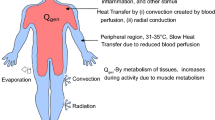Abstract
The paper describes a study into one aspect of the thermoregulatory control system in man. An analysis of this control system led to the hypothesis that thermoregulation in humans is achieved by two basic control systems that act as first and second lines of defence and that influence each other. Available physiological information has been utilised in a digital computer simulation of the vasomotor activity associated with the first stage of human thermal control. In exploring features of the model it has been shown that the incorporation of on-off control allows two key aspects of the control system associated with thermal vasomotor activity to be duplicated: (a) the spontaneous fluctuations in digit blood flows; (b) the ability of a thermally induced disturbance to entrain these spontaneous fluctuations. It has also been possible to illustrate driving frequency dependence of the entrainment phenomenon both in the physical system, by physiological experimentation, and in the computer model.
Sommaire
Cet article dêcrit une étude réalisée sur l'un des aspects du système thermorégulateur de l'homme. Une analyse de ce système de contrôle a conduit à l'hypothèse que la thermorégulation chez les humains se réalise au moyen de deux systèmes de base agissant en tant que première et deuxième lignes de défense et qui influent l'un sur l'autre. Les informations physiologiques actuellement disponibles ont été employées pour une simulation par ordinateur numérique de l'activité vasomotrice associée au premier étage de la thermorégulation chez l'humain. Lors de l'étude approfondie des caractéristiques du modèle, il a été démontré que l'incorporation d'une commande ‘marche/arrêt’ permet de reproduire deux aspects fondamentaux du système de contrôle associé à l'activité vasomotrice thermique. Il s'agit d'une part des fluctuations spontanées du flux sanguin exprimé en valeur numérique et d'autre part de la capacité de toute perturbation provoqucé par la chaleur de produire ces fluctuations spontanées. Il a été possible en outre de mettre en évidence la subordination de l'effet moteur au facteur ‘fréquence’ pour ce qui est du phénomène d'entrainement, et ce aussi bien dans le système physique au moyen d'expériences physiologiques que dans le cadre d'une simulation par ordinateur.
Zusammenfassung
Die Arbeit beschreibt dic Untersuchung eines Aspektes der menschlichen Temperaturregelung. Eine Analyse dieses Regulationssystems ftihrte zu der Hypothese, dass die Wärmeregulierung beim Menschen durch zwei Hauptsteuersysteme erfolgt, die als erste und zweite Verteidigungslinie wirken und einander beeinffiussen. Vorhandenes physiologisches Material wurde zur digitalen Computersimulation der vasomotorischen Tätigkeit, die der ersten Stufe tier menschiichen Wärmeregulierung entspricht, benutzt. Die Untersuchung von Einzelheiten des Modells zeigte, dass das Vorsehen einer Ein-Aus-Steuerung zwei Schlüsselaspekte des der zu duplizierenden thermischen vasomotorischen Tätigkeit entsprechenden Steuersystems zulässt, nämlich die spontanen Schwankungen im digitalen Blutstrom und die Fähigkeit einer auf thermischem Wege herbeigeführten Störung, diese spontanen Schwankungen auszulösen. Es war ferner möglich, die Abhängigkeit des Auslösephänomens von der Antriebsfrequenz sowohl im physischen System dutch physiologisches Experiment wie bei dem Computermodell zu veranschaulichen.
Similar content being viewed by others
References
Aschoff, J. andWever, R. (1958) Kern and Schale im Wărmehaushalt des Menschen.Naturwissenschaften 20, 477–485.
Brengelmann, G. L. andBrown, A. C. (1963)Physiologist 6, 146–153.
Burton, A. C. (1939) The range and variability of the blood flow in the human fingers and the vasomotor regulation of body temperature.Amer. J. Physiol. 127, 437–453.
Burton, A. C. andTaylor, R. M. (1940) A study of the adjustment of peripheral vascular tone to the requirements of the regulation of body temperature.ibid. 129, 563–577.
Crank, J. andNicolson, P. (1947) A practical method for numerical evaluation of solutions of partial differential equations of the heat condution type.Proc. Camb. Phil. Soc. 43, 50–67.
Crosbie, R. J., Hardy, J. D. andFessenden, E. (1963) inTemperature—Its measurement and control in science and industry J. D. Hardy, Ed.,3 (3). Reinhold, New York, 627–635.
Liang-Tseng Fan, Fu-Tong Hsu andChing-Lai Hwang (1971) A review on mathematical models of the human thermal system.IEEE Trans BME 18, No. 3.
Minorsky, N. (1962)Nonlinear oscillations Van Nostrand, London and New York.
Stolwijk, J. A. J. (1970) Mathematical model of thermoregulation. inPhysiological and behavioural temperature regulation Ed.Hardy, J. D. Gagge, A. P. andStolwijk, J. A. J. Charles C. Thomas, Illinois, 703.
Author information
Authors and Affiliations
Rights and permissions
About this article
Cite this article
Kitney, R.I. The analysis and simulation of the human thermoregulatory control system. Med. & biol. Engng. 12, 57–65 (1974). https://doi.org/10.1007/BF02629835
Received:
Accepted:
Issue Date:
DOI: https://doi.org/10.1007/BF02629835




